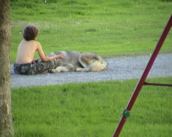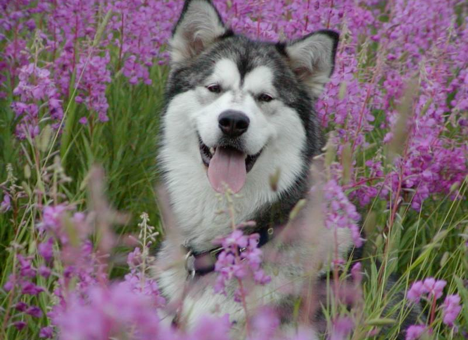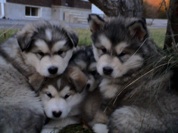Story about bravery




May 5, 2000
Iqaluit men credit Huskies' dogged determination for reaching Pole
Trip helps support Peary's claims
SEAN McKIBBON
Nunatsiaq News
IQALUIT — The sudden cracking sound didn't alarm Paul Landry and Paul Crowley as they rested in their tent one night on their journey back from the North Pole.
"We took a look outside — the tent was still where we put it," said Crowley. The pair of Iqaluit men didn't think much more about it.
Until the second crack, when the howling started.
"A crack in the ice had formed across where the dogs were staked," said Crowley. The two adventurers looked outside their tent again and saw their dog team split into two groups by a crack in the thick polar ice. One set of dogs was with Landry and Crowley — the other was being carried away.
Worse, two dogs had been dragged into the frigid water by their tie-out chain, which had snapped under the force of the ice sheets moving apart.
In the tense minutes that followed, Landry and Crowley found out exactly why the husky breed has served Inuit so well, and saw first-hand the determination in the dogs that they believe carried American explorer Robert Peary to the North Pole in 38 days — a feat unmatched by later expeditions and viewed by many as impossible and a fraud.
On March 2 Landry and Crowley started their 764 km journey in an attempt to match or beat the pace of Peary.
"After this trip I have no doubts that he accomplished what he said he did," Landry said.
In the first half of their trip Crowley and Landry stayed ahead of Peary's schedule, taking only 17 days to get as far north as Peary's Borup Camp at 85 degrees, 23 minutes north latitude. And although their eventual time to the Pole was four and a half days behind Peary's schedule, Landry and Crowley said their time is close enough to indicate that Peary's 24-man expedition could have made the trip in the time he claimed. They point out that Peary had the advantage of more experienced dog drivers, better snow conditions, igloos and cached supplies.
Landry and Crowley faced deep, soft snow conditions, thinner ice and more pressure ridges — differences they attribute to global warming. They also had only two sleds, a single re-supply, and 12 dogs — one of which had just minutes to live if it couldn't be pulled from the frigid ocean.
By the time the two men were able to throw on their parkas to rescue their team there was a 12-foot distance between them and the other group of dogs. One of the two dogs had managed to drag itself from the water. The other was still trying to escape the icy liquid.
"He was like a dog trying to get out of a pool that isn't full," said Crowley. "You know, he was scratching at the side trying to get up but he couldn't." Crowley said he walked north and then south along the edge of the crack looking fruitlessly for a place where one of the men could cross.
Then Landry found a piece of ice floating between the two larger pieces. After a quick bout of "do you want to go?" between the two, Landry braved the unstable footing and used the smaller piece of ice to get to the dogs.
After hoisting the half-frozen dog out of the water and then covering him over with snow to keep him warm, Landry managed to move the other dogs back across to Crowley. He then went back for the dog he had rescued from the water and dug him out. But by this time the gulf had widened. Crowley secured a rope to the small piece of ice with an ice axe and pulled first the dog and then Landry across to him.
"The dogs can be quite mischievous," said Landry, "but when things are serious they can hear it in your voice that this is not the time for fooling around."
He said that no other breed of dog would have been able to recognize the seriousness of the situation and actually follow their commands to cross the makeshift ice bridge, let alone survive the extreme temperatures.
"Those dogs really came through," said Landry.
Landry and Crowley brought the rescued dog into their tent and held him over a Coleman stove to thaw him out. They then massaged the dog to get his circulation going.
"After two hours the dog took himself out of the tent," said Crowley. The dog rolled in the snow before falling asleep with his pack, joining them in front of a sled the next day.
For Landry and Crowley it was the performance of their dogs under harsh conditions that provided the most satisfaction.
Actually reaching the Pole was anti-climactic, they said.
"When you get there there's nothing, it just looks the same as everything else," said Landry. What they enjoyed more was simply the opportunity to spend time together.
"We'd spend hours talking about Peary and what it must have been like back then," said Crowley.
"I think it really cemented our friendship," Landry said of the trip.


Story about bravery







